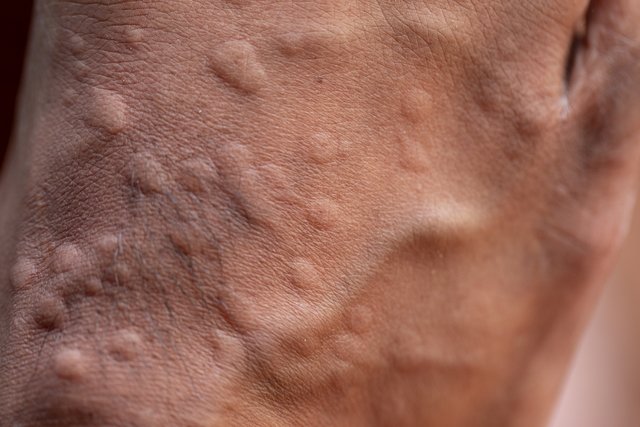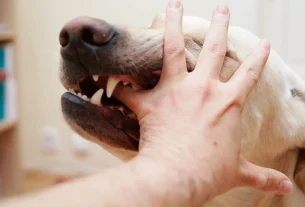Ant bites are not normally considered serious, causing mild symptoms such as pain, redness, small elevations in the skin and itching in the area, due to the action of the ant venom.
However, although it is rare, there is a risk of ant bites causing serious allergic reactions, especially in people more sensitive to the venom, children and the elderly, which can be life-threatening.
In case of ant bites, if the symptoms are intense or take a long time to improve, it is recommended to consult a general practitioner for an evaluation. Treatment typically involves measures such as keeping the area clean and avoiding scratching, and the use of ointments for insect bites, according to the doctor’s advice.

Main symptoms
The main symptoms of ant bites are:
- Pain or burning at the site of the bite;
- Itching in the affected part of the body;
- Small elevation in the skin;
- Blister with pus;
- Redness, especially around the bite;
- Swelling.
Normally, symptoms begin soon after the bite, but the pus-filled blister can take up to 24 hours to appear and around 1 week to disappear. Additionally, redness and swelling can sometimes affect areas of up to 10 cm of skin.
Ant sting allergy symptoms
Symptoms that may indicate an ant bite allergy include:
- Itching on the body;
- Intense swelling;
- Large area of redness on the skin;
- Nausea or vomiting;
- Diarrhea;
- Abdominal pain;
- Shortness of breathe;
- Low pressure.
These symptoms normally develop in less than 30 minutes after the bite and may indicate serious allergic reactions such as anaphylaxis, and it is recommended to seek an emergency room for evaluation if they occur. Find out more symptoms of anaphylaxis.
Is a black or red ant bite dangerous?
A black or red ant bite can be dangerous in some cases, depending on the ant species, number of bites and the person’s sensitivity to the venom. Although serious reactions are rare, bites from these ants can be life-threatening, especially in cases of allergies.
What to do in case of an ant bite
In case of an ant bite, you must:
- Remove the ant from the areabecause sometimes the ant is trapped by its jaws in the body;
- Remove parts of the ant that may have remained in the skinpassing gauze or your fingernail lightly over the area;
- Wash the bite site with soap and waterto prevent it from infecting;
- Apply ice to the biteto reduce pain and swelling;
- Avoid scratchingso as not to worsen swelling, itching or risk of infection;
- Do not burst the bubble if it appearsto avoid infection from the bite;
- Use ointments with corticosteroids or antihistaminesaccording to the doctor’s advice, to relieve itching and reduce inflammation in the area.
Furthermore, if there is a history or suspicion of allergy to ant bites, you should avoid being alone, seek an emergency room for an evaluation and initiate appropriate treatment.
In case of anaphylaxis, treatment may involve injecting epinephrine, serum and medications directly into the vein, such as corticosteroids and/or antiallergics. See how anaphylaxis is treated.
Ant bite ointment
The most recommended ointments for ant bites are the same ones used for bites by other insects and contain corticosteroids or antihistamines in their composition, such as hydrocortisone, dexamethasone or dexchlorpheniramine. Discover other ointments recommended for insect bites and how to use them.
How to avoid ant bites
Some measures recommended to avoid ant bites are:
- Avoid walking near anthillsespecially barefoot;
- Do not mess with ants or their anthillsto prevent ants from becoming aggressive;
- Use protective equipment and appropriate clothingsuch as gloves, pants and closed shoes, when taking care of the garden or moving the soil, especially if there are anthills;
- Be careful when handling dead animalsbecause there may be ants on the carcasses.
Furthermore, when carrying out outdoor activities, such as picnics, playing or playing sports, especially in areas with grass, dirt or bushes, it is important to check the area to make sure there are no ant trails or anthills.
Bibliography
- CDC. Fire Ants. Available at: <https://www.cdc.gov/niosh/topics/insects/fireants.html>. Accessed on March 30, 2023
- CDC. NIOSH Fast Facts: Protecting Yourself from Stinging Insects. Available at: <https://www.cdc.gov/niosh/docs/2010-117/default.html>. Accessed on March 30, 2023
- WANANDY, Troy et al. Global View on Ant Venom Allergy: from Allergenic Components to Clinical Management. Clinical Reviews in Allergy & Immunology. Vol.62. 123–144, 2022
- STATPEARLS. Fire Ant Bites. 2022. Available at: <https://www.ncbi.nlm.nih.gov/books/NBK470576/>. Accessed on March 30, 2023

Sign up for our newsletter and stay up to date with exclusive news
that can transform your routine!
Warning: Undefined array key "title" in /home/storelat/public_html/wp-content/plugins/link-whisper-premium/templates/frontend/related-posts.php on line 12
Warning: Undefined array key "title_tag" in /home/storelat/public_html/wp-content/plugins/link-whisper-premium/templates/frontend/related-posts.php on line 13



